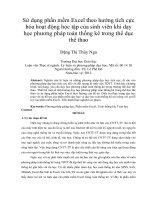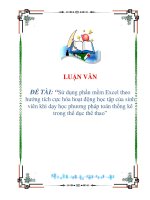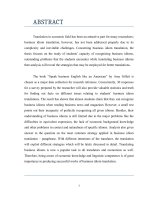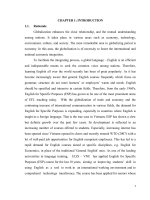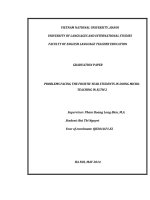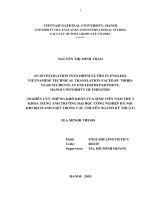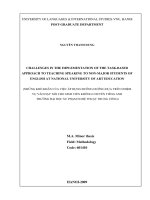KHÓ KHĂN của SINH VIÊN KHI DỊCH ANH VIỆT THÀNH NGỮ KINH tế TRONG QUYỂN SÁCH nói TIẾNG ANH KINH tế NHƯ NGƯỜI mỹ của AMY GILLETT
Bạn đang xem bản rút gọn của tài liệu. Xem và tải ngay bản đầy đủ của tài liệu tại đây (500.53 KB, 71 trang )
ABSTRACT
Translation in economic field has been an attractive part for many researchers;
business idiom translation, however, has not been addressed properly due to its
complexity and inevitable challenges. Concerning business idiom translation, the
thesis focuses on the study of students’ capacity of recognizing business idioms,
outstanding problems that the students encounter while translating business idioms
then analysis will reveal the strategies that may be employed for better translations.
The book “Speak business English like an American” by Amy Gillett is
chosen as a major data collection for research reference. Concurrently, 30 responses
for a survey prepared by the researcher will also provide valuable statistics and truth
for finding out facts on different issues relating to students’ business idiom
translations. The result has shown that almost students claim that they can recognize
business idioms when reading business news and magazines However, a small test
points out their incapacity of perfectly recognizing all given idioms. Besides, their
understanding of business idioms is still limited due to the major problems like the
difficulties in equivalent expression, the lack of economic background knowledge
and other problems in context and naturalness of specific idioms. Analysis also gives
answer to the question on the most common strategy applied in business idiom
translation – paraphrase. With different intentions of the translator, the translation
will exploit different strategies which will be lately discussed in detail. Translating
business idioms is now a popular task to all translators and economists as well.
Therefore, being aware of economic knowledge and linguistic competence is of great
importance in producing successful works of business idiom translation.
i
Table of Contents
LIST OF FIGURES AND TABLES
Figure 1: Demonstration of research process
Figure 2: Frequency of encountering with business idioms among surveyed students
Figure 3: Surveyed students’ ability of understanding business idioms
Figure 4: Major problems as perceived by students
Table 1: Statistics in survey results
Table 2: Students’ translations for given business idioms in translation practice test
ii
Table 3: Suggested translation for given business idioms in the translation practice
test
Table 4: Proportion of translation strategies applied by surveyed students
LIST OF ABBREVIATIONS
SL Source Language
TL Target Language
ST Source Text
TT Target text
ULIS University of Languages and International Studies
VNU Vietnam National University
iii
PART 1: INTRODUCTION
1.1. RATIONALE
It goes without saying that linguistic constructions like business idioms are
involved with metaphors and based on associations of meaning that have not been
sufficiently studied yet. It stands to the reason that translating idioms appears to be
the most difficult task, from identifying an idiom, making it out and distinguishing
idiomatic from non-idiomatic usage. Therefore, mastering idiomatic understanding is
in the urgent need for anyone being fond of making better use of native-like English
expressions. Especially in business related filed, concise sentences are conventionally
appreciated. Nevertheless, in the context of broader integration and corporation,
business discussions dyed with cultural colors are inevitable; hence specialized
idiomatic expressions are applied as a common phenomenon.
Additionally, day-by-day translators have chances to convey big volume of
articles from well-known magazines all over the greatest financial cities around the
world. The common trend is an amazing number of idioms that always occurs in
even the shortest article in any business publication – The Economist, Financial
Times, Bloomberg Business Week, Forbes, Fortune, CNN Money and so on. It is
convinced impossible for translators to use accurate Vietnamese terms to express
English business idioms without strategically tackling these complex combinations of
words and sentences.
These aforementioned motivations have therefore inspired the implementation
of this study. Specific area chosen for the study is impressive idiomatic expressions
extracted from 67 – page book named Speak Business English like American by Amy
Gillett. This will be carried out with the title:
1
“English – Vietnamese translation of business idioms in the book Speak
Business English like an American by Amy Gillett”
1.2. OBJECTIVES OF THE STUDY
The study is carried out with the aim to provide learners with fundamental
knowledge in translating idiomatic expression of business terms, especially in the
base of listed business fields in Speak Business English like an American. With
thoroughly investigation into different aspects in studying specific business idioms,
the research would find out the procedures and strategies frequently used by the
translators in conveying idiomatic expressions from English into Vietnamese.
Moreover, implications for further English – Vietnamese translation in specific
business idioms will be suggested.
1.3. RESEARCH QUESTIONS
To achieve these aforementioned goals, the study will deal with the following
questions:
1. What are the common problems in translating specific
business idioms as perceived by surveyed students?
2. What translation strategies are used to convey the
meaning of specific business idioms?
1.4. SCOPE OF THE STUDY
Each idiom translation has its own specific challenges to translators to handle
with; various solutions therefore are offered. Nevertheless, limited time and capacity
has narrowed the thesis scope to emphasize on studying, analyzing and suggesting
translations to business idioms discovered in the book “Speak business English like
an American”. In addition, aspects to investigate into the business idiom area are
broad; hence, the thesis would pay special attention to analysis of translation
problems and procedures which are applied in translating those selected idioms.
1.5. METHODS OF THE STUDY
2
In this study, quantitative method in the form of survey questionnaires is much
resorted to. All the considerations and conclusions are mainly based on the data
analysis and references.
The collected data will be analyzed in comparing and contrasting techniques
to find out the problems that learners cope with in translating specific business
idioms relating to many business fields as mentioned in the sample book.
Besides, discussion with the supervisor, colleagues, personal experience, and
material studying from previous researches, newspapers and magazines are also
significant contributions to the study.
1.6. SIGNIFICANCE OF THE STUDY
To begin with, the study, as stated, aims to support students of translation
major in particular and anyone who shares the same interest in idiom translation.
With careful analysis of the findings in the research, students will be provided with
the most common knowledge around the issues of recognizing problems in their
business idioms translation.
Secondly, learners can figure out techniques and strategies that can be
exploited and applied into their future translation practices.
Last but not least, the study will play the role as a motivation tool for English
users who desire to better their English – Vietnamese interchange skills through a
concise list of business idioms that can be discovered in the book “Speak Business
English like an American”.
1.7. STRUCTURE OF THE STUDY
Part 1: Introduction
Part 2: Development of the study
Chapter 1: Literature review
Chapter 2: Methodology
Chapter 3: Findings and discussion
Part 3: Conclusion
PART 2: DEVELOPMENT OF THE STUDY
3
Chapter 1: LITERATURE REVIEW
1.1. PREVIOUS STUDIES
In English, many linguists did research on idioms such as Ammer, Cowie et
al., Cruse, Fernando, Warren and so on. In Vietnamese, there have also been a lot of
authors whose studies generally related to idioms such as Duong Ngoc Dung and
Ninh Hung, Tran Phong Giao, Hoang Van Hanh, Nguyen Luong Van Dang and so
on. Among them, “Idiom Organiser” by Jon Wright (2002) is widely used by learners
all over the world. In his well-known book, idioms are clarified and organized by
metaphor, topics and key words, which are practically useful to all idiom learners.
For English dictionaries, a very famous one that catches concerns of all
scholars and learners is so-named “The American Heritage Dictionary of Idioms” by
Christine Ammer. In this dictionary, the author lists idioms currently used in
American English and arranges them into alphabetical categories. He also explains
their meanings and clarifies them by examples. Besides, “Oxford Learner’s
Dictionary of English Idioms” by Helen Warren - a comprehensive dictionary
tackling general idiomatic expressions in current English also gives examples and
explanations of unusual features of grammar and usage. Another is “Oxford
Dictionary of Idioms” by Judith Siefring which provides learners with updated
idioms including clear explanations in typical contexts. “Cambridge Dictionary of
American Idioms” by Paul Heacock gives clear and understandable illustrations on
each idiom as well as their origins
Besides, huge numbers of Vietnamese and English idioms can be found in
many books, magazines of other authors and there has been quite a lot of MA
thesises on various aspects of English and Vietnamese idioms. Up to now, there have
also been roughly 100 M.A theses done in various aspects of idioms in Vietnam.
4
However, there is no evidence that any research on investigating the topic of my
thesis has been carried out completely so far.
1.2. TRANSLATION
1.2.1. Definition of Translation
Translation studies have witnessed rapid growth particularly over the past
decades, a myriad of studies have defined the term translation. According to Nida
and Taber (1982:12), “translation consists in reproducing in the receptor language the
closest natural equivalence of the source language (SL) message firstly, in terms of
meaning and secondly, in terms of style”. In their definition, Nida and Taber pointed
out the major bases of translation which involves two languages, the source language
(SL) and the target one (TL), and it can be oral or written; however, it is the context
dependent and equivalence is one of the most vital elements.
Translation also is a work, “a craft” (Peter Newmark, 2006), in which the
original message must be remained exactly the same in the target text thanks to the
creature work of the artists – the translators. A good work highlights the
achievements of both linguistic and artistic effects.
1.2.2. Equivalence in translation
Equivalence is probably the most controversial issue discussed in translation
theory. In the simplest way, equivalence can be clarified as a term used to describe
the nature and the extent of the relationship between the SL and TL text.
Different scholars gave different access to understanding of equivalence in
translation: Baker (1992) studied form-based equivalence .i.e. equivalence at
grammatical levels (word, sentence then text level), Nida (1964 – 1969) introduced
function-based equivalence (dynamic and formal equivalence), and Koller (1990)
emphasized the necessity of meaning-based equivalence (denotative, connotative,
pragmatic and formal equivalence). Each approach presents hard-tackling challenges
for translators.
5
By launching the of “equivalent in different”, Jackobson (cited in Bassnett
1980: 39) keeps the point of view that translation can always be carried out
regardless of the cultural or grammatical differences between the S and T text.
Whenever the translator cannot find an exact equivalent to a specific SL,
“terminology may be qualified and amplified by loan words or loan translations,
neologisms or semantic shift”.
Armstrong (2005:45) shares the same ideas with Jackobson, “full equivalence
is rare”; however, nearest possible equivalent should be found out and considered.
Different authors and writers have introduced different approaches to
translation equivalence. For a translator, awareness of equivalence plays a crucial
role. The translator are required to understand the characteristics of each equivalence
type in order to utilize it appropriately, especially in technical translation of such
texts as literary texts, cultural texts, medical texts The issue of equivalence is
especially important when it comes to translation revision and quality assessment.
Because a good translation not only satisfies the requirement of meaning but also
other requirements, like styles, communicative value or aesthetic effects…
1.2.3. Non-equivalence in Translation
Non-equivalence in translation is often met due to the differences between the
SL and the TL at cultural, grammatical, lexical or stylistic levels.
According to Baker (1992), non equivalence may be at the level of word or
above word level including translating idioms and collocations. Non equivalence at
word level can occur because of the absence in the target culture of a relevant
situational feature that is conceptually lexicalized for the source language text
(Bassnett, 1980:39). The existence of non-equivalence usually is above word level as
words always do not occur on their own, but “almost occur on the company of other
words” (Baker, 1992:46). Sometimes, a single word does not make sense until it is in
a combination with others to create a full expression of an idea. Namely, as Johnson
(1975) cited, the great pest of speech is frequently of translation. No book was ever
turned from one language into another, without imparting something of its nature
6
idiom; this is the most mischievous and comprehensive innovation, single words may
enter by thousands and the fabric of the tongue continue the same, but new
phraseology changes much once; it alters not the single stories of the building, but
the order of the columns (Baker, 2001:46).
Non-equivalence above word level faces with concepts or ideas expressed by
metaphors, collocations and idioms then this study’s task is to deal with translating
idioms in a specialized field.
1.2.4. Translation procedures.
Classifications of translation procedures have been cleared out by numerous
researchers such as Nida (by changes of order, omissions, structure, addition), Vinay
and Darbelnet (by loan, calque, literal translation, transposition, modulation, total
syntagmatic change, adaption). However, Peter Newmark, as far as I am concerned,
made greatest contribution in clarifying different translation procedures applied in
sentences and smaller units of language like words, phrases and idioms. His work of
“A textbook of translation” has introduced eight typical translation procedures
including transference, naturalization, through translation, shift/ transposition,
modulation, cultural equivalent, functional equivalent and descriptive equivalent.
If transference procedure is applied, a SL word will be directly taken into the
TL text without any small change or simple translation, this word therefore will be
called as a “loan word”. This procedure is most suitable for cultural, new technical
terms, or proper names to create certain stylistic effects, for example, modernity or
unique. Naturalization “succeeds transference and adapts the SL word first to the
normal pronunciation” (Peter Newmark), i.e. the way to pronounce a word is used to
denote its concept in the TL. Next, through translation is the literal translation of
common collocations, names of organizations, the components of compounds, and
often applies to translation of regionally or internationally organized names.
Shift or transposition appears to be a level-up process relating to the change in
the grammar/ part of speech. This is due to the difference in preferred equivalent
grammatical structure between the two languages and also to the goal of performing
7
naturalness in translation. Meanwhile, modulation offers a variation in the message
when it is translated into a target language due to a change in point of view. It could
be in the way of talking about one part to mean another, discussing positive side to
double negate it or, using the passive form to express the active one.
Cultural equivalence is a more complex procedure in which a SL cultural
word or expression is translated by a TL cultural word considered equivalent to it, for
example, the expression “as cool as a cucumber” in English can be translated by
“lạnh như tiền” in Vietnamese, or many other ways based on preferred measurements
in different countries. Also, functional equivalence is the replacement of cultural
word with a cultural-free expression in a translation. This procedure is appreciated as
“the most accurate way of […] deculturalising a cultural word” (p.83). Newmark also
introduced descriptive equivalence as a procedure which allows translator to explain
or paraphrase the words in the target language. This procedure shares something in
common with free translation.
1.3. IDIOMS AND TRANSLATION
1.3.1. Definition of idioms
One of the most complicated but luring part of English in use is that of idioms.
Idioms are still frequently used in various contexts, from daily life conversations and
business meetings to highly formal written format. Learners apply idiomatic
expressions into their speech to make it more native-like, but this requires of deep
competence of English and may easily lead to misusage. Severely, idiom recognition
always gets the most confusing. Questions raised around idioms have been a
mountain; however, in the easiest way, “an idiom is a kind of complex lexical item. It
is a phrase whose meaning cannot be predicted from the meanings of the morphemes
it comprises” (Langacher: 1968:79). Idioms are characterized as “a fixed group of
words with a special meaning that cannot be guessed from the combination of the
actual words used” (Longman Dictionary of Contemporary English, 1981). For
instance, on every Thanksgiving occasion, it is extremely easy to catch sight of
“Black Friday Specials” advertisement which is an accurate and popular idiom, not
8
“Golden Sunday” or “Red Friday”. Therefore, wrong-use of idioms is popular and
more frequent is the failure to convey English idiomatic expression into Vietnamese.
It is due to the reason that “idiom’s meaning cannot easily be worked out from the
words it contains. Idioms have the potential to cause foreign learners of a language to
some difficulty. If you say to a native speaker visiting a place for the first time, ‘how
did you find Stratford?’ you will get the response ‘great-I loved it; or I did not like
the place at all’. But if you ask a nonnative speaker the same question, the response
may be ‘how did I find Stratford? The train took me there. Here ‘find’ is used
idiomatically”. (Jarvie, 1993:148)
1.3.2. Common problems in translating non-equivalence
A translation problem is any type of difficulty or obstacle that the translators
have to encounter in conveying the ideas of the source text into the target one. This
obstacle is commonly clarified as grammatical, stylistic, cultural or lexical problems.
However, to idiom translating, the obstacles are usually narrowed down to the
difficulties in handling with stylistic, cultural or lexical problems.
1. Grammatical Problems
Grammatical problems rise as the indispensable consequence of the
complexity in grammar of the SL, or more specifically, in different way to organize a
word, a sentence, an expression in English and in Vietnamese. Most frequent
grammatical problems can be listed out as:
- The translation of auxiliary verbs “be”, have” and modal verbs.
- The translation of adjectives and personal pronouns as The TL
has superordinate while the SL does not.
- The translation of nominal, verbal and conditional sentences.
- The translation of complex / compound word order.
2. Stylistic Problems
The problem of translation equivalence is closely connected with the stylistic
aspect of translation cannot reach the required level of equivalence if the stylistic
peculiarities of the source text are neglected. Full translation adequacy includes as an
9
obligatory component the adequacy of style, i.e. the right choice of stylistic means
and devices of the target language to substitute for those observed in the source text.
The style, or the way of writing, of a particular SL text may pose different
problems for the translator. One of these problems is fronting, in which a word, a
phrase or a clause is stated at the beginning of a sentence in an unusual way. For
instance, “suicide he committed” instead of “he committed suicide”. The purpose
behind such a fronting is to emphasize on the fronted word, or to draw attention to its
importance to the meaning of the whole sentence.
Other stylistic problems may include parallelism, ambiguity, redundancy, and
nominalization vs. verbalization (Ghazala, 1995:18-24).
3. Cultural Problems
A variety of problems come to be long-lasting and enormous issues in cross-
cultural translation as “the greater the gap between the source and target culture, the
more serious difficulty would be”. (Yowelly and Lataiwish, 2000:107). English and
Vietnamese translation involves two totally different cultures (the Western and the
Oriental cultures), which supply a favorable background for such cultural problems.
Cultural problems may include geographical, religious, social and linguistic ones.
4. Lexical Problems
Baker (1992) has paid great contributions in identifying common problems in
translating non-equivalence. In terms of lexical problems, one case is when the SL
word is semantically complex, i.e, when one word is complex in its lexical meaning,
it results in translation problems. Besides, The SL may poses a wide variety of
specific terms (hyponyms) that drive the translators into confusing situations when
making a right word-choice.
Also regarding non equivalence, difficulties in translating may be due to the
differences in fixed and idiomatic expressions between SL and TL. This poses
numerous challenges for translator, especially when the author intends to refer to
both literal and figurative meanings of an expression (Huyen N. T., 2011)
1.3.3. Translation strategies
10
Trosborg in his work “Text Typology and Translation” (1997) as well as the
article of Henrik Gottlieb referring to translation strategies of English idioms called
“Idioms in Subtitles vs Printed Translation” claims that if the translator sees the
original structure and form of the ST relevant for the expression and semantic
features in the translation, “he must bring the reader to the text” (Gottlieb, 1997,
317). Namely, it is necessity that the translators take efforts in conveying all the
culture-specific items and language specific elements like idioms found in the ST.
The purpose of such translation is not to rigidly impose the style of the ST to the TT.
However, if it is not appropriate and accurate when the primitive feature of the ST is
maintained, then the translator needs to “[bring] the text to the reader” (Gottlieb,
1997, p.317). That is, a certain modification can be applied in the TT. The changes
may be in style or form and expression of the text. For instance, idioms in the TL
may not be rendered as idioms at all. If the translator chooses the strategy of not
preserving the text with too close similarity with the original text then two possible
strategies can be suggested by Gottlieb as:
“[focusing] on the meaning of the original text” and,
“[focusing] on the intended effect on the reader”
(Gottlieb, 1997, p.317)
With the first strategy, they translator may decide to be loyal to the style in the
TT, which is called as “stylistic loyalty” – recreating the verbal atmosphere of the
original. The second strategy pays more attention to translator’s choice for
“conceptual loyalty, aiming at adapting the original text to a new communicative
situation” (Gottlieb,1997:317).
Idiomaticity in translation sometimes means that idioms should not be
translated by idioms. Sometimes the search for the target language idiom always
grabs the priority mission. The same like many other languages, English, especially
English for specific purposes may record no idiomatic concept. Eckhard Roos
showed his contributive arguments in idiom translating. According to that,
1. SL idioms matched by TL idioms:
11
a. Congruence (identical at word level)
b. Equivalence (differing at word level)
2. SL Idioms matched by other TL lexemes:
a. Single-word matches
b. Formula (non metaphorical multi-word matches)
c. Free form (encyclopedic renderings) (Gottlieb 1997, p.319)
Another scholar, Bo Svensen, suggests other four categories for translating
idioms:
1. Idioms with identical metaphors in SL and TL
2. Idioms with related metaphors
3. Idioms with different metaphors
4. SL idioms with no metaphorical counterparts.
(Gottlieb 1997, p.319)
In the work In Other Words (1992), Mona Baker points out four following
strategies for translating idiomatic expressions:
1) using an idiom with the same meaning and form,
2) using an idiom with the similar meaning but different form,
3) paraphrasing,
4) by omission.
In conclusion, knowledge of translation and idioms definition, obstacles in the
process of translating specific business idioms above mentioned would effectively
support this research as a strong theoretical background and make the outcome of the
research more reliable.
12
PART 2: DEVELOPMENT OF THE STUDY
Chapter 2: METHODOLOGY
This part gives a concise presentation on research subjects, research
instruments. In addition, phrases in the research process will be clearly indicated.
2.1. SELECTION OF SUBJECTS
The dominant research samples are excerpts from the book titled Speak
Business English like an American by Amy Gillett. This book is a precious material
for any learner who is engaged in sharpening his native-like style around business
talks. Addressing a study on it, various business idioms regarding a myriad of
business fields will be discovered in excitement. The success of the book has gained
tremendous compliments from users, scholars and linguistics. As featured in the Wall
Street Journal, with Speak Business English like an American, you can “communicate
like a native speaker of English with the ultimate guide to today’s Business English”.
Different sources are employed in seeking answers for the research questions.
The first source comes from trustful recognized bilingual dictionaries – these
translations hereafter become official acknowledged translations. Besides, by
referring to great Vietnamese idiom and proverb treasures, the answered are also
concluded. In a broader lookup, several domestic and foreign websites or forums for
English learners are chosen; these personal translation versions therefore mostly
reflect diversified subjective analysis and translation. Last but not least, asking for
suggestions from experienced translators and Business English lecturers is
unavoidably a useful tool for a more completed outcome.
13
2.2. DATA COLLECTION INSTRUMENTS
As stated in the previous sections, the study purpose is to examine English
learners’ ability of providing proper translations for frequently-met business idioms;
it later comes to give out strategies for better improvement in translating.
In this study, survey questionnaires are designed to assess learners’ abilities of
recognizing and understanding business idioms and then realize their major problems
and difficulties in doing this hard-solving task. Specifically, the survey form is
produced including of two main parts, the Case Testing Questionnaire and the
Translation Practice Task. Results are collected from 30 randomly-picked
Vietnamese students who have studied both English and Economics at University of
Languages and International Studies. Questionnaire papers are delivered to students
of class 09E24, 09E23, 09E17 in duration of 10 days, from 10
th
March to 20
th
March,
2013.
After concluding out the common problems that learners encounter in
recognizing and understanding business idioms, solutions will be revealed by
suggested strategies for translating.
2.3. RESEARCH PROCESS
Two stages of research process are conducted alternately. In the very
beginning step, responses for the research’s surveys are carefully classified,
examined and reported in detailed percentage charts and summarized conclusion of
students’ difficulties in translating business idioms.
Moving to the second stage, research subjects are chosen, analyzed and
investigated by the researcher to find out the most applicable and useful strategies.
This phase brings out the findings of the researcher to put them into a comparative
scale with other authentic and reliable sources.
As an illustration, the diagram below will give a more descriptive outline for
research process:
14
15
Figure 1: Demonstration of research process
PART 2: DEVELOPMENT OF THE STUDY
Chapter 3: RESULTS AND DISCUSSION
This most important part of the study reveals findings from the results of
student survey together with the researchers’ inferences with different reliable
sources.
3.1. RESULTS FROM THE SURVEY
Student survey as the first instrument investigated to find out common
problems and difficulties among students when translating business idioms,
especially the ones studied in the book “Speak Business English like an American”
by Amy Gillett. The survey handles with the first research question: What are the
common problems in translating specific business idioms. Answers are concluded
through collecting, combining and comparing 30 different sheets. Solutions to
researchers’ questions are guaranteed purely random picked. Students have time to
check and refer to multimedia and material sources in order to ensure that their
translation tasks are fulfilled with all their best.
The findings come to three facts: 1) recognizing business idioms and the
frequency of encountering them; 2) the difficulties of students in translating business
idioms; and 3) the common mistakes made by students in translating selected
business idioms.
Charts and tables are exploited effectively to demonstrate the results. Apart
from these tools, clear explanation will be given out respectively.
3.1.1. Recognizing business idioms and the frequency of encountering
them.
16
This part firstly will give an insight into the statistical fact of the frequency of
encountering business idioms in daily news, magazines and materials. In the next,
students’ ability to recognize a business idiom will be revealed through their
answered survey questions.
The survey question 1 - “Can you recognize an idiom when reading business
news?” – has recorded 30 frank and straight answers from 30 random surveyed
students. The result is not out of expectation, 28 students out of 30 claimed that they
surely can realize an idiom when reading business news. It is a notable result that
marks over 93.33 % of surveyed students can recognize business idioms – the very
hard – to understand because of its abstraction in language generally and in business
particularly. On the other hand, only 2 students admitted their incapacity of
recognizing business idioms.
In order to check the truthfulness of students’ self-judgments, I give surveyed
students a small practice case-conversation.
“In a company’s meeting,
- We are losing a lot of business to your competition.
- Yes, our competition is eating our lunch.
- We may be at a loss if we don’t bail the sales department out.”
Four business idiomatic expressions are found in this conversation, “to lose
business to your competition”, “our competition is eating our lunch”, “at a loss”,
“bail the sales department out”. Nevertheless, collecting all their answers for
identifying business idioms occurred in the conversation, it comes to the fact that
students are not really sure about their ability to recognize business idioms. Results
showed that only 2 students were able to point out four applied idiomatic
expressions. Almost the rest (14 students) found out three out of four business
idioms. The next equal group consists of 11 students who underlined two business
idioms in the whole provided conversation. Amazing result also tells that three
students left only could indicate only one idiom. Overall result for the survey
question 1 is provided in the table below:
17
Can recognize
business idioms
28 No. of idioms was
found
No. of students
1 2
Cannot recognize
business idioms
2 2 14
3 11
4 3
Table 1: Statistics in survey results
Regarding the quantity of idioms found in the conversation, the figures cannot
tell about the real ability of surveyed students in recognizing business idioms. The
fact is that students cannot know exactly which ones are business idioms. Apart from
2 cases perfectly cleared out four idioms, the rest virtually underlined the whole
sentences or just the phrase verbs contained in the idiomatic expressions only. The
problem here obviously is that students are ambiguous about the true structures of
each idiom.
The question of frequency is answered through survey question 2, which is
demonstrated in the chart below:
18
Figure 2: Frequency of encountering with business idioms among
surveyed students
As what can be seen from the chart, a noticeable portion of 50% surveyed
students admitted their common encounter with business idioms when reading
business news. At the same time, the number of students who always cope with
business idioms also is a considerable figure – 30%. No-one denies their meeting
with business idioms while about 20% surveyed students acknowledge their unusual
contact with business idioms. These above statistics have shown the popularity of
business idioms in use; hence the need to improve knowledge on understanding
business idioms is vital and immediate to all students, especially with ones having
daily contact with business affairs and materials.
Nevertheless, the factual status of students’ understanding regarding business
idioms still requires further discussion for improvement.
To prove this authentically, result of the survey question 3, “How do you
understand those business idioms?” can give the clearest illustration to surveyed
students confession on their real situation of business idiom understanding ability.
The results are drawn as in the below figure:
Figure 3: Surveyed students’ ability of understanding business idioms
19
When students can identify exactly what the business idioms are, it still cannot
be assumed that students can see through the meanings of those idioms. The figures
from the above chart have specified the reality of surveyed students’ ability of
understanding business idioms. A majority of surveyed students (65%) claimed that
they sometimes understand the business idioms that they coped with. The group that
rarely understands business idioms accounts for a smaller proportion (27%). No case
dares to affirm their absolute understanding of business idioms while to a surprise,
8% of surveyed students really do not understand the business idioms that they have
just pointed out.
Therefore, in order to help students themselves give the explanation to their
failure to make out the meaning of business idioms they met, I provide the fourth
survey question – “What is your biggest problem in translating business idioms?”
Answers have been collected then according to them; I have been completing reports
on their problems when translating, which will be presented in detail in the next part.
3.1.2. The outstanding problems that students face.
The question of outstanding problems that students face in translating business
idioms is investigated through the survey question 4 – “What is your biggest problem
in translating business idioms?” The results are revealed as following:
20
Figure 4: Major problems as perceived by students
The survey targets to students studying both majors, English Translating and
Interpreting and Economics. Therefore, their knowledge and skills confirm the
truthfulness of their shares regarding the actual problems they perceived during their
interaction with business materials. As the chart showing that different students meet
different challenges in translating business idioms. Among various listed difficulties,
difficult equivalent expression and lack of economic background knowledge are the
two most common problems coming up to 38% and 35% surveyed students
respectively put a thumb up for the selection. Different expressions due to the
mismatch between SL and TL are always big problem for all languages’ translators
and interpreters. The next vote belongs to the option of “lack of materials to
compare” with 11% answers. Although the extending networks have offered a
myriad of search tools for students, this “lack of materials” is still understandable as
the information provided widely on the Web is almost untrusted and multisided. The
results have demonstrated the left three problems with fewer effects on the surveyed
students, which are “complex lexical organization” (8%), “unclear context” (4%) and
“no equivalence in the target language” (4%). Under the level of senior year
university students, only a small portion of students considered these as their biggest
21
problems in translating is reasonable as their knowledge of both English and
economic issues by this time is sufficient enough for this lowest level of
comprehensive reading. The biggest problem lies in each one’s ability of best
transferring messages and content of each idiom from SL to TL.
However, in conclusion for difficulties in translating business idioms, major
problems are listed out as follow:
The mismatch between the SL and the TL, rooting from the differences in
culture, as well as numerous variations of cultural words used in idioms, acts as the
major cause to translating business idioms. The complexity in the translating English
business idioms into Vietnamese is already predicted by the definition of idioms as a
complex linguistic expression whose whole meaning may be different from meaning
of each individual words that make up the expression (Lipka,1990:96). Idioms
express an abstract meaning, which means that a high semantic complexity in SL will
be conveyed to a relatively concise figurative expression in TL.
Besides, these linguistic constructions are built based on different rhetorical
figures such as metaphors or comparisons, hyperboles or others. This use of
languages and semantic words until now has not been understood fully yet.
Therefore, it would be extremely hard for translators to guess the meaning without
looking up for the cultural base, religious base or social base of the idioms in
different relevant sources.
Fuertes Olivera & Samaniego Fernández (1998: 41-45) in their work have
studied that the meaning of plentiful business idioms is motivated by a small set of
traditional symbols or metaphors belonging to a portion of popular categories such as
machines, liquids, human body, daily life, animals, plants, colors, medicine, war,
sports, games and so on. This finding indicates the possibility of predicting the
figurative meaning of business idioms. Fraile Vicente (2005) has successfully
proved this through this research in which he collected two groups of conceptual
metaphors that can be used to describe the conceptual structure of economics and the
meaning of its idioms. These metaphors empower the economists to vary the extent
22
